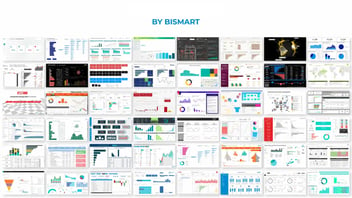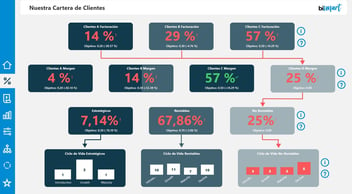This article provides tips on how to make our dashboards and performance indicators useful and valuable.
Most companies use dashboards to keep track of their activity. However, most dashboards only display data and information and do not provide insights. This article explains how to fix that and how to make your dashboards useful.

In the article 'What Is a Dashboard in Data Analytics and Business Intelligence?', we already mentioned that companies use dashboards to measure their performance, monitor business activity, support the decision making process and drive actions.
For a dashboard to fulfil its function and be of real use, it is essential that it does not merely corroborate information. A dashboard must provide added value so that information is transformed into knowledge and so that knowledge is useful for the day-to-day running of the company.
Data, information and knowledge
Confusing the terms data, information and knowledge is a common misunderstanding. However, they are not the same and understanding the difference between data, information and knowledge is critical to make our performance indicators and dashboards valuable.
What is data? Data is nothing more than the symbolic representation or description of a situation or event. In the business environment, data alone does not convey a message.
Let's imagine that a dashboard shows the following data: "Turnover: 5 million euros". This data does not provide a message because, for example, we do not know which company the turnover belongs to, what period of time it is from, nor do we have any other number to compare it with. For data to communicate a message, it must be complemented with information.
What is information? Information is nothing more than a set of data put in its context so that it provides knowledge. In other words, information is the ability to communicate knowledge or produce intelligence. In business, information can influence our value judgements or our perception of something.
In short, information is the connection of data to its context and must always provide some kind of knowledge or intelligence.
What is knowledge? Knowledge is the collection of facts and information acquired by a person through his or her experiences, the education received and/or theoretical or practical understanding of a matter related to reality. In order for information to become knowledge, it must be useful for reality, act as a support tool for business decision-making and promote the concretisation of actions.
What does a useful dashboard look like?
Bismart has helped many companies implement dashboards and we have our own dashboard solution. Our experience has allowed us to identify that many business leaders share a common concern: their dashboards only provide information that they already have.
When an unusual result is observed, an efficient dashboard should help us decide what actions to take in order to correct the problem.
How to make a dashboard useful?
In order for a dashboard to be useful and provide insight and value, it is essential that we take these considerations into account when creating it:
- Decide what you want to measure and for what purpose: It is extremely important to spend time thinking about what information you want your dashboard to have and why.
- Selecting the right performance indicators: We should also choose the most appropriate performance indicators based on what we want to measure and why we are interested in measuring it.
- Implement actionable dashboards: A dashboard is actionable when it helps us to make decisions and take action, whether preventive or corrective, in order to address those indicators that are anomalous or could be counterproductive in the future.
- Bring out the pain points hidden in the information: A good dashboard should bring out the company's pain points, which are often hidden within data. An effective dashboard is one that does not force an executive to navigate through multiple visual objects or screens in order to find out why an issue is problematic or the cause of a bad result. Instead, it is the dashboard that should automatically show us why we are not meeting an objective.
What characteristics should a performance indicator have?
For a dashboard to be productive, it is essential that it includes the right indicators. At the end of the day, a dashboard is only the platform that brings data and information together and transforms it into knowledge, but if the performance indicators are not correctly defined, the dashboard will be inefficient.
Any indicator, whether strategic, tactical or operational, should meet at least these 5 characteristics:
- Actionable: Everyone within an organisation should be able to influence the outcome of an indicator through their activity.
- Quantifiable: The measurement of any indicator must be objective and statistically observable. Under no circumstances can it be subordinated to subjective criteria.
- Understandable: The indicators must be known and understood by any member of the company. In other words, the indicators, especially the strategic ones, must be accessible to the entire company and be expressed in a language that can be understood by all team members.
- Repeatable: Indicators should be repeatable and sustainable over time. An indicator that can only be used for a single month or for a single project is of little use.
- Timely: The basic function of a performance indicator should be to provide the right information on what we want to uncover.
Benefits of a performance indicator
Indicators have numerous benefits. Some of the most important from a business perspective are:
- They support the company's objectives, the decision-making process and the implementation of actions. The purpose of performance indicators is to enable us to measure how close we are to achieving our business objectives. In addition, they should help us to make decisions and implement actions aimed at achieving those objectives.
- They create an atmosphere of learning, collaboration and continuous improvement. Having indicators helps us to detect where we may be failing or where we could improve. Presenting indicators in working or management committees encourages discussion and fosters a process of continuous improvement.
- They strengthen teamwork and align the organisation's objectives. If we define our indicators correctly, we will be able to align all members of the company towards achieving our strategic objectives. For example, it would not make sense to have reducing delivery time to customers as a strategic objective and, on the other hand, for the logistics department not to have an operational indicator focused on achieving it. If we align all our indicators we will be able to encourage teamwork and get all employees to work in the same direction.
- They foster personal growth and transparency. Sharing indicators promotes transparency in all corporate areas. Furthermore, weighting indicators stimulates personal growth and the achievement of the company's goals.
Business indicators: Tips and good practices
Establishing performance indicators is a decisive step for any company.
What should we do when establishing our indicators?
- Dedicate time to reflect on the usefulness of each indicator. One of the most important aspects, and one to which not enough time is often devoted, is to reflect on the utility of each indicator. When choosing an indicator, we should ask ourselves why we need it, if we really need it and if it helps us to measure what we want to achieve.
- Define a maximum of 2 KPIs per objective or business area. Some companies have more than 1,000 indicators. Nonetheless, too much information is just as damaging as too little. Obviously, each business must apply its own logic and the number of indicators chosen will also depend on the scope of our dashboard. However, best practices recommend that we have a maximum of two indicators per area.
- Monitor and analyse our indicators regularly. Once we have our dashboard it is essential that we take the time to monitor and analyse our indicators. To promote a process of continuous improvement, analysing our dashboard's data regularly is crucial.
- Inductive indicators. An inductive indicator is one that predicts a future outcome. For example, our dashboard shows the monthly sales indicator in red, there is nothing we can do because the month has already been closed. Inductive indicators anticipate future results based on preceding indicators applying a cause-and-effect logic. This allows correcting adverse results and solving problems before they occur.
Is my dashboard useful?
The fact that data brings value to companies is no secret. However, if we are unable to take advantage of it, data is of no use.
This is why it is so important to think about whether our scorecard provides knowledge or just information, whether it is useful for decision making, whether it helps us to identify problems and whether it provides us with the keys to correct them.
In short, for a dashboard to be truly effective, it is essential that it is not merely a platform where information is presented and that the user does not need to carry out a data-discovery process to obtain knowledge. On the contrary, it is the scorecard that should directly illustrate the logic of problems, pain points and the reasons behind them.



